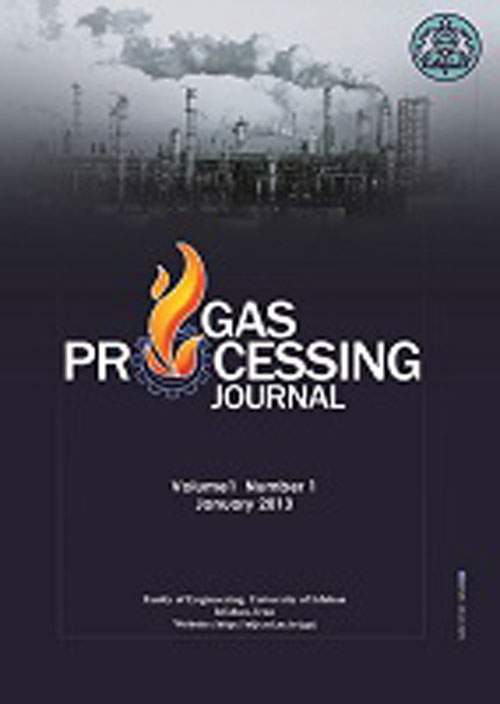فهرست مطالب

Gas Processing Journal
Volume:8 Issue: 2, Autumn 2020
- تاریخ انتشار: 1399/08/06
- تعداد عناوین: 6
-
-
Pages 1-12
CO2 plays the most important role in pollution due to greenhouse gases, which causes global warming and climate change. Unfortunately, CO2 emission has increased significantly in recent decades. So, it is crucial to capture CO2. On the other hand, CO2 can be utilized for commercial products. There is plenty of CO2 utilization such as enhanced oil recovery (EOR), producing methanol, salicylic acid, urea, and so on. This paper tries to consider the applications of CO2 emitted from ethane treatment units of the Asalouyeh gas processing plant. But selecting the best application is a complex issue. A multi-criteria decision-making method, fuzzy TOPSIS (Technique for Order Preference by Similarity to an Ideal Solution), considering economic, technical, and environmental aspects have been used to find the best application for CO2 utilization. Considering 10 criteria and comparing options with sensitivity analysis in 32 different modes, the results show that methanol production is often the best option and salicylic acid production is the worst option. It should be noted that the increase in the harvest with a very close distance in the majority of cases is the second priority.
Keywords: Ethylene Epoxidation, Ethylene Oxide, Rhenium, Silver, Strontium Titanate -
Pages 13-22
In this study, silver catalysts on SrTiO3 support contain cesium, and rhenium promoters are synthesized using the impregnation method for ethylene epoxidation reaction. SEM results show a small decrease in metal dispersion by adding cesium (3 catalyst. Rhenium leads to the weakening of the peaks intensity in the crystalline structure of the catalysts. In addition, the predominance of Ag (111) surface facets compared to the Ag (110) and Ag (100) surface facets are obvious in the XRD results. The ability of the catalysts in oxygen adsorption and desorption is studied through O2-TPD results. Ethylene conversion increases by adding rhenium to the Ag-Cs/SrTiO3 catalyst in the temperature range of 210 to 220 °C. Ethylene oxide selectivity increases slightly from 80% to 84% in the Ag-Cs-Re/SrTiO3 while this value in the Ag-Cs/SrTiO3 catalyst decreases from 65% to 34%, in the mentioned temperature range. Severe sensitivity of the rhenium-conation catalyst to the inlet concentration of carbon dioxide (6 mol %) is observed through a 50% drop in the produced ethylene oxide compared to the product which doesn’t have any carbon dioxide in the feed.
Keywords: Ethylene Epoxidation, Ethylene Oxide, Rhenium, Silver, Strontium Titanate -
Pages 23-34
Natural gas compressor stations in gas transmission industries cause to increase gas pressure and discharge to gas transmission pipeline. Air coolers in compressor station, have high electrical energy consumption and pressure drop. In this investigation, the application of heat pipe heat exchangers (HPHE) in a case study of the gas compressor station is evaluated to use instead of air coolers. The result of the investigation shows that applying 620 heat pipes with a 50% filling ratio, working fluid R134 and arranged triangularly, can reduce the compressed natural gas temperature. Energy performance analysis shows that using this method improves total, thermal, and electrical energy performance indicators (3%, 2.4 %, and 78%, respectively). Also simulating process demonstrate that using HPHE cause to save 1,115,000 SCM fuel in gas turbine and 3,800 MWh electrical saving in air coolers. In addition, results show with using HPHE 2,615,000 $ cost saving is available and project payback period value less than 1 year evaluated, and avoiding 1652 ton CO2 emission estimated annually.
Keywords: Energy performance, Natural gas Cooling, Heat pipe -
Pages 35-50
In this study, Kaolin, Bentonite, and Feldspar were used as a low-cost source of Si and Al to synthesize the molecular sieve 13X. The synthesized Zeolites were characterized by XRD, FTIR, SEM, TGA, and BET analysis and used as a suitable adsorbent for CH4 adsorption. The surface areas were 591, 505, 472, and 588 m2/g for natural kaolin (13X-K), bentonite (13X-B), feldspar (13X-F) and commercial molecular sieve 13X (13X–C), respectively. The 13X-K had the highest thermal stability than 13X-B and 13X-F. The adsorption capacities (pressure >20bar) of 13X (kaolin), 13X (bentonite), and 13X(feldspar) were 3.6, 2.4, and 1.95 mmol/g, respectively. The adsorption data were fitted to some isotherms including Langmuir, Freundlich, Sips, BET, and Toth. It was found that the Sips model showed better fitting in comparison to other models. The thermodynamic of adsorption was also investigated; the positive value of ∆S_ads^0 revealed the increased randomness at the solid-solution interface during the gas adsorption. The thermodynamic study also indicated that the adsorption process was exothermic and spontaneous. The adsorption capacities of synthesized 13X samples were compared to other adsorbents; it was found that 13X–K showed considerable performance and can be introduced as a suitable adsorbent for applications on a large scale.
Keywords: Methane, 13X, Adsorption, Isotherm, Thermodynamic -
Pages 51-60
Iran is one of the major oil-producing countries in the world. However, because of the environmental pollutions of fossil fuels, pay attention to the development of the renewable energy sources must be considered. The principal objective of this paper is to assess the situation of the fuel cells' power capacity in Iran. CO2 is the most major greenhouse gas. According to the outcomes, at by 2030, the installed capacity of fuel cells is about 3451457 kWh, which can be reduced CO2 emissions if be applied instead of the fossil fuel power plants. According to the Paris Agreement, business as usual in Iran, CO2 emissions must be reduced by 4% (74 million tons) to 2030. The results show that on average, fuel cell technology can decrease CO2 emissions by replacing with one fossil power plant with the a value of 0.003% of 74 million tons. Based on the outcomes of the prediction, if the government of Iran pays attention to the development of the fuel cell technology, this technology has an acceptable potential in reducing CO2 emissions. Finally, to determine the external cost reduction using fuel cell technology and the amount of the income of the export saved natural gas, an economic analysis is performed.
Keywords: fuel cell, CO2 emissions, 2030, Iran, environmental pollutions, renewable energy -
Pages 61-67
Fuel reactivity controlled compression ignition (RCCI) engines are promising approaches to achieve high efficiency and clean combustion. Using biogas as a primary fuel in the engines causes better control of the combustion process due to its reactivity gradient with diesel fuel. In this study, biogas is inducted into the engine through an inlet port, and diesel as a high reactivity fuel is injected into the engine. At a constant engine speed of 1300 rpm and a fixed amount of diesel mass, a broad range of indicated mean effective pressure from 5.6 to 13.5 is studied. Also, the effects of different compositions of biogas and biogas to diesel ratio on combustion characteristics and emission levels are studied. Results show that changes in the amount of CO2 in biogas composition lead to drastic changes in maximum pressure, temperature, and emission levels. In other words, increasing the amount of CO2 in biogas and also the ratio of biogas to diesel both significantly decrease maximum pressure, temperature, and NOx emission.
Keywords: Reactivity controlled compression ignition, biogas, diesel engine, emission


